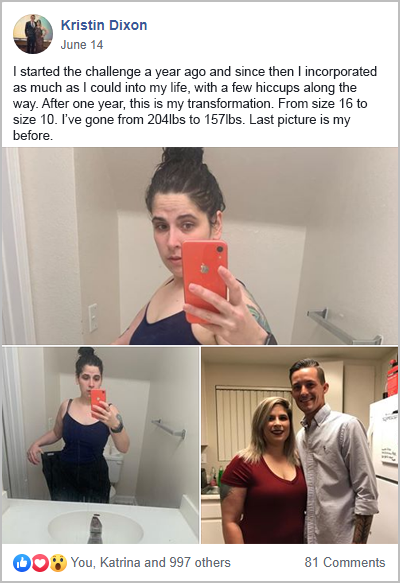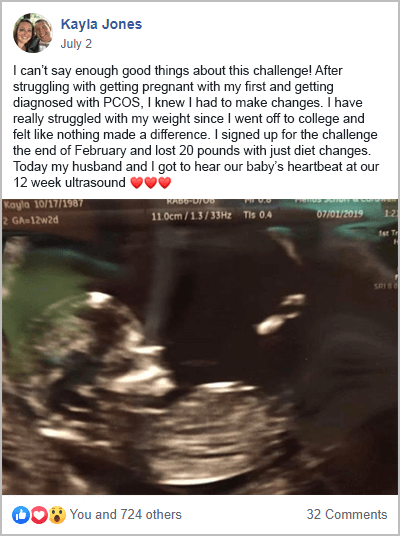Key Takeaways
Polycystic ovary syndrome is a collection of symptoms caused by elevated androgens, insulin resistance, and chronic inflammation. What and how you eat alters these mechanisms and can resolve all PCOS-related health issues.
During my free 30-Day PCOS Diet Challenge, I show participants exactly how to do this right. I give them nutritional video lessons, PCOS-friendly meal plans, and an engaging community to keep them on track. Many women notice meaningful weight loss within a few short weeks. Countless others have restored their period and gone on to have healthy, successful pregnancies.
But making PCOS-friendly dietary changes isn’t easy. A good PCOS diet often means making food from scratch. This inevitably means more prep time and washing up.
This is why smoothies, when done right, can be so helpful. They’re quick to prepare, you can drink them anywhere, and clean-up is minimal.
The “when done right” bit is key, though. Many “healthy smoothies for PCOS” may not be that healthy. High sugar content, even from fruit, can be counterproductive. This is especially true for weight loss. Milk or whey protein powders are also unsuitable for any smoothie recipes for PCOS. These ingredients can harm the gut adding fuel to a pre-existing problem with inflammation. See my PCOS and dairy article to understand this better.
The selection of smoothies presented below are examples of more suitable recipes for women with PCOS. Whether you want a snack, a meal replacement, or something fun, I hope you’ll find what you need.
How To Make A PCOS-Friendly Smoothie
Here’s how to make the best smoothies for PCOS weight loss and fertility:
- Add plenty of healthy fat and protein. These macronutrients provide lasting satiety and energy without spiking blood sugar levels. Good sources of fat and/or protein for PCOS smoothies include almond butter, coconut cream, flax seeds, and chia seeds. Using a PCOS protein powder is also a great idea.
- Use ingredients that are rich in micronutrients, antioxidants, and gut-loving fiber. Non-starchy vegetables, spices, nuts, and seeds are particularly helpful. Leafy greens, especially spinach, are particularly good for making green smoothies.
- Minimize sugar content. Whole fruit and coconut products are the best sweeteners for PCOS-friendly smoothies. Frozen banana and frozen cherries, for example, are good ingredients for PCOS smoothies. Frozen fruit is preferable to natural sweeteners like raw honey because they provide more nutrients and fiber. But these, too, should be used wisely. If you’re loading your blender with fruit and fruit juice, all you’re doing is shooting up sugar. This is the last thing that women with PCOS need.
- Avoid whey protein powder, milk, and other dairy products which cause inflammation. It’s much better to use almond milk, coconut milk, and other dairy-free alternatives.
Create your smoothie by adding ice and any frozen ingredients into your blender first. Then add liquids, followed by greens and other vegetables. Place softer ingredients, such as fruit, on top. Finish with seeds and powders before processing until smooth.
5 PCOS Smoothie Recipes
- Supercharged Green Smoothie
- Nutty Chai Smoothie
- Spicy Veggie Smoothie
- Chocolate Chia Pudding
- Chai Tea Frozen Yogurt
Note: These last two are more of a dessert smoothie option, but still packed full of nutrient-dense ingredients.
More PCOS Recipes
Check out these blogs for some of my other free PCOS recipes:
Or see my review of the best PCOS cookbooks here.
The Bottom Line
PCOS can be managed with the right diet and lifestyle. Smoothies can play a valuable role in this process. A good PCOS smoothie or smoothie bowl can be a quick and convenient way to nourish yourself. But you must get the ingredients right. Choose ingredients that are dairy-free, low in sugar, and nutrient-dense.
If you’re trying to lose weight, get pregnant, or manage other PCOS symptoms, take back control of your health today. Download this free 3-Day Meal Plan and join my free 30-Day PCOS Diet Challenge.
PCOS Success Stories
It’s one thing to know that a PCOS diet is good for you. It’s another to see life-changing results in women just like you. If you want to lose weight with PCOS or you’re trying to get pregnant with PCOS, then I hope Kristin and Kayla’s stories will inspire you. These women both participated in my free 30-Day PCOS Diet Challenge.


PCOS Smoothie Recipe FAQs
Why is it best to avoid dairy milk and whey protein for PCOS? Some women with PCOS can tolerate dairy proteins. But many others have an adverse reaction to these foods, sometimes without realizing it. Consuming dairy in the presence of a sub-clinical dairy sensitivity increases systemic inflammation. As I explain in detail in my PCOS and dairy article, this makes many PCOS symptoms worse.
How much fruit can I use in a smoothie? Grapes, bananas, and mango are high-sugar fruits. They have more than three times as much sugar as berries and currants. As a general guide, one medium-sized piece or half a cup serving per day is a good amount for limiting sugar intake.
Can I use a smoothie as a meal replacement? Yes, but be mindful that this may not provide enough nutrition to keep you going. Adding extra fat and protein, like a side of boiled eggs, is recommended when using smoothies to replace a meal.
What types of protein powders are okay to use when you have PCOS? Anything that doesn’t have added sugar or whey protein is likely to be fine. Pea protein isolate is one of the best options for amino acid profile and bioavailability. But hemp protein tastes the best.
Author
As a Nutritionist, I’m continuing my mission to help women like you, beat PCOS. Evidence-based diet and lifestyle interventions helped me overcome five years of infertility. I fell pregnant naturally after multiple failed IVF cycles. Along the way, my other PCOS symptoms went away too. This experience taught me how to combine the latest science with a pragmatic approach to habit change. I’ve now helped thousands of other women achieve life-changing results, and I love for you to be the next PCOS success story. Learn more about me and what I do here.
As a Nutritionist, I’m continuing my mission to help women like you, beat PCOS. Evidence-based diet and lifestyle interventions helped me overcome five years of infertility. I fell pregnant naturally after multiple failed IVF cycles. Along the way, my other PCOS symptoms went away too. This experience taught me how to combine the latest science with a pragmatic approach to habit change. I’ve now helped thousands of other women achieve life-changing results, and I love for you to be the next PCOS success story. Learn more about me and what I do here.






